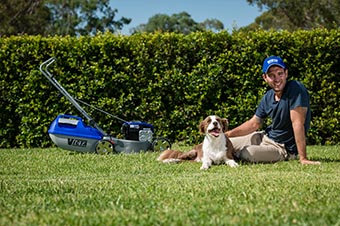IMPROVE YOUR LAWN BY MULCH MOWING
As we move towards the warmer months your lawn will jump back to life and that means it’s time to get that mower back out of the shed! It’s considered good practice to switch from mulch-mowing to traditional catcher mowing over the cooler months so right about now it’s time to be flipping that around and switching back to mulching.
Mulch-mowing is often poorly, or at least superficially, understood by many home-owners. Here’s the background on why you really need to be getting into mulch-mowing and how you can maximise its benefits for your lawn and soil.
First off... what exactly is mulch-mowing?
Traditional lawn mowing deals with grass clippings in one of two ways – they are collected in a catcher or discharged, often in big clumps, through a chute, back onto the lawn.
The former means stopping and starting to empty the catcher, and mountains of clippings to be disposed of, while the later often requires raking the lawn post-mow if you’re after a neat finish.
Apart from the extra time and effort both techniques involve there’s also often wastage of what can be a very useful resource – grass clippings. Then there’s mulch-mowing.

A mulching mower works in a somewhat different way. The lawn is cut, but then, rather than the clippings being immediately sent to the catcher of discharge chute, they are thrown higher under the mower deck and, in less than the blink of an eye, they are cut and recut to super-fine clippings before being blown downwards into the turf thatch. Victa mulch-mowing models achieve this through their unique mulching blade-disc design which maximises air-circulation and clipping movement under the deck.
Once these clippings are back in the lawn thatch, that’s the layer below the blades of grass, they function like mulch, helping to retain moisture and protecting the grass roots from temperature extremes. Both definite bonuses however that is only part of the story.
The simple fact is that mulch-mowing makes your mowing a much more sustainable practice through the benefits it brings and waste it avoids. It’s easy to think only of these obvious physical mulching benefits but the pluses run much deeper, right down into the soil in-fact.
When it comes to the quality of the performance of any plant, whether it be your lawn or garden plants, the most important, and potentially most limiting, factor is soil quality. Your soil isn’t just a place for plants to anchor their roots to draw water and food. It is layer upon layer of living, breathing microorganisms, from earthworms to tiny bacteria and fungi, that do everything from creating optimum soil structure for drainage and aeration to converting raw nutrients to forms that can easily be used by your lawn.
When you mulch-mow ideally those tiny clippings will breakdown and rapidly enter the soil as nutrients and in the process help to improve soil structure and quality. It’s not a stretch to say that every time you mulch-mow you are lightly organically feeding your grass and the soil. This process of breakdown is of-course aided and accelerated by those communities of soil microorganisms. After a cold winter or hot and dry periods or even just in old, tired lawns these micro-communities can become quite depleted and this reduces the benefits of mulch-mowing as the breakdown process becomes too slow.
The easy way to fix this is to apply prebiotic or probiotic products to your lawn as part of your lawn care regime. A seaweed-based hose-on product such as Seasol for lawns* will both feed and work as a prebiotic, providing the right ingredients to kick-start soil microorganism activity. To take it one step further use a lawn fertiliser such as PowerFeed LawnFeed*. It’s fortified both with seaweed extracts and beneficial microbes making it probiotic to not just stimulate, but increase, the populations of beneficial microorganisms virtually as soon as it’s applied.
This magic combination of mulch-mowing and soil-friendly lawn care products means that your mowing isn’t just keeping your lawn looking fantastic. Every time you mow you will be feeding your lawn and improving your soil quality building a healthier, stronger, more resilient lawn that will perform at its best under virtually any conditions.




